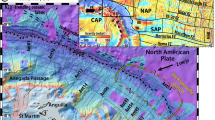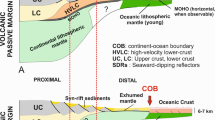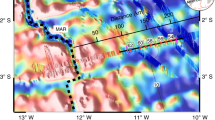Abstract
The great Sumatra earthquake of 26 December 2004 was the third largest event to occur in a subduction zone in the past 50 years. The rupture initiated at 30–40 km depth northwest of Simeulue Island1 and propagated for ∼1,300 km to the northern Andaman Islands2. The earthquake was caused by sudden slip along the plate interface between the subducting Indo-Australian plate and the overriding Sunda plate3,4. Although detailed knowledge of the structure of the subduction interface is important to define potential sources of large megathrust earthquakes, available data5,6,7,8 have not provided such information so far. Here we present a high-quality seismic section of the focal region, from the abyssal plain down to 40 km depth below the fore-arc. The seismic data reveal that the subducting crust and oceanic Moho—the crust–mantle boundary—are broken and displaced by landward-dipping thrust ramps, suggesting that the megathrust now lies in the oceanic mantle. We image active thrust faults at the front of the accretionary wedge, consistent with thrust aftershocks on steeply dipping planes. Our observations imply that very strong coupling leading to brittle failure of mantle rocks accounts for the initiation of such an exceptionally large earthquake.
This is a preview of subscription content, access via your institution
Access options
Subscribe to this journal
Receive 12 print issues and online access
$259.00 per year
only $21.58 per issue
Buy this article
- Purchase on Springer Link
- Instant access to full article PDF
Prices may be subject to local taxes which are calculated during checkout




Similar content being viewed by others
References
Lay, T. et al. The Great Sumatra–Andaman Earthquake of 26 December 2004. Science 308, 1127–1133 (2005).
Ammon, C. J. et al. Rupture process of the 2004 Sumatra–Andaman earthquake. Science 308, 1133–1139 (2005).
Rhie, J., Dreger, D, Bürgmann, R. & Romanowicz, B. Slip of the 2004 Sumatra–Andaman earthquake from joint inversion of long-period global seismic waveforms and GPS static offsets. Bull. Seismol. Soc. Am. 97, S115–S127 (2007).
Vigny, C. et al. Insight into the 2004 Sumatra–Andaman earthquake from GPS measurements in southeast Asia. Nature 436, 201–206 (2005).
Henstock, T. J., McNeill, L. C. & Tappin, D. R. Seafloor morphology of the Sumatran subduction zone: Surface rupture during megathrust earthquakes? Geology 34, 485–488 (2006).
Sibuet, J.-C. et al. 26th December 2004 Great Sumatra–Andaman Earthquake: Seismogenic zone and active splay faults. Earth Planet. Sci. Lett. 263, 88–103 (2007).
Dewey, J. W. et al. Seismicity associated with the Sumatra–Andaman Islands earthquake of 26 December 2004. Bull. Seismol. Soc. Am. 97, S25–S42 (2007).
Engdahl, E. R., Villasenor, A., DeShon, H. R. & Thurber, C. H. Teleseismic relocation and assessment of seismicity (1918–2005) in the region of the 2004 Mw 9.0 Sumatra–Andaman and the 2005 Mw 8.6 Nias Island Great earthquakes. Bull. Seismol. Soc. Am. 97, S1–S19 (2007).
Kopp, H., Flueh, E., Klaeschen, D., Bialas, J. & Reichert, C. Crustal structure of the central Sunda margin at the onset of oblique subduction. Geophys. J. Int. 147, 449–474 (2001).
Park, J.-O. et al. A deep strong reflector in the Nankai accretionary wedge from multichannel seismic data: Implications for underplating and interseismic shear stress release. J. Geophys. Res. 107 10.1029/2001JB000262 (2002).
Singh, S. C. et al. Seismic reflection images of deep lithospheric faults and thin crust at the at the actively deforming Indo-Australian plate boundary in the Indian Ocean. Eos. Trans. AGU 88, Fall Meet. Suppl., Abstract T22E-06 (2007).
Ranero, C. R., Phipps Morgan, J., McIntosh, K. & Reichert, C. Bending-related faulting and mantle serpentinization at the Middle America trench. Nature 425, 367–373 (2003).
Franke, D. et al. The great Sumatra–Andaman earthquakes-Imaging the boundary between the ruptures of the great 2004 and 2005 earthquakes. Earth Planet. Sci. Lett. 269, 119–130 (2008).
Deplus, C. et al. Direct evidence of active deformation in the eastern Indian oceanic plate. Geology 26, 131–134 (1998).
Abercrombie, R. E., Antolik, M. & Ekström, G. The June 2000 Mw 7.9 earthquake south of Sumatra: Deformation in the India-Australia plate. J. Geophys. Res. 410, 74–77 (2003).
Graindorge, D. et al. Interaction/links between lower plate and upper deformation at the NW Sumatran convergent margin from seafloor morphology. Earth Planet. Sci. Lett. 10.1016/j.epsl.2008.04.053 (2008, in the press).
Chlieh, M. et al. Coseismic and afterslip of the great Mw 9.15 Sumatra–Andaman earthquake of 2004. Bull. Seismol. Soc. Am. 97, S152–S173 (2007).
Calvert, A. J., Ramachandran, K., Kao, H. & Fisher, M. A. Local thickening of the Cascadia forearc crust and the origin of seismic reflectors in the uppermost mantle. Tectonophysics 420, 175–188 (2006).
Samuel, M. A., Harbury, N. A., Bakri, A., Banner, F. T. & Hartono, L. A new stratigraphy for the Islands of the Sumatran Arc, Indonesia. J. SE Asian Earth Sci. 15, 339–380 (1997).
Klingelhoefer, F. et al. First results from the SAGER-OBS deep seismic cruise (July/August 2006) offshore Sumatra. Geophys. Res. Abs. European Geosciences Union 9, A6263 (2007).
Wang, C. Y. Sediment subduction and frictional sliding in subduction zones. Geology 8, 530–533 (1980).
Subarya, C. et al. Plate boundary deformation with the Great Sumatra–Andaman earthquake. Nature 440, 46–51 (2006).
Banerjee, P., Politz, F., Nagarajan, B. & Bürgmann, R. Coseismic slip distributions of the 26 December 2004 Sumatra–Andaman and 28 March 2005 Nias earthquakes from GPS static offsets. Bull. Seismol. Soc. Am. 97, S87–S102 (2007).
Shelly, D. R., Beroza, G. C., Ide, S. & Nakamula, S. Low-frequency earthquakes in Shikoku, Japan, and their relationship to episodic tremor and slip. Nature 442, 188–191 (2006).
Hyndman, R. D., Wang, K & Yamano, M. Thermal constraints on the seismogenic portion of the southwestern Japan subduction thrust. J. Geophys. Res. 100, 15373–15392 (1995).
Simoes, M., Avouac, J. P., Cattin, R. & Henry, P. Sumatra subduction zone: A case for a locked fault zone extending into the mantle. J. Geophys. Res. 109, B10402 (2004).
Abercrombie, R. E. & Ekström, G. Earthquake slip on ocean transform faults. Nature 410, 74–77 (2001).
Kohlstedt, D. L., Evans, B. & Mackwell, S. J. Strength of the lithosphere: Constraints imposed by laboratory experiments. J. Geophys. Res. 100, 17587–17602 (1995).
Natawidjaja, D. et al. Source parameters of the great Sumatran megathrust earthquakes of 1797 and 1833 inferred from coral microatolls. J. Geophys. Res. 111, B06403 (2006).
Wang, K. & Hu, Y. Accretionary prisms in subduction earthquake cycles: The theory of dynamic Coulomb wedge. J. Geophys. Res. 111, B06410 (2006).
Feldl, N. & Bilham, R. Great Himalayan earthquakes and the Tibetan plateau. Nature 444, 165–170 (2006).
Acknowledgements
We thank Schlumberger for its overall support and contribution to this project, and in particular, we recognize the efforts made by the captain and crew of the WesternGeco Q-Marine vessel, Geco Searcher. J.-P. Montagner and J. Ludden provided constant support for the Sumatra–Andaman Great Earthquake Research (SAGER) initiative. Agence National de la Recherche (France) and IPG Paris financially supported the participation of scientists in the survey. This is a collaborative project between the Government of Indonesia (BPPT & LIPI), Schlumberger (WesternGeco) and the Institut de Physique du Globe (IPG) de Paris. We thank R. Engdahl for providing aftershock relocations. Comments by D. Scholl helped improve the manuscript. This is IPGP contribution number 2432.
Author information
Authors and Affiliations
Corresponding author
Supplementary information
Supplementary Information
Supplementary Information (PDF 14709 kb)
Rights and permissions
About this article
Cite this article
Singh, S., Carton, H., Tapponnier, P. et al. Seismic evidence for broken oceanic crust in the 2004 Sumatra earthquake epicentral region. Nature Geosci 1, 777–781 (2008). https://doi.org/10.1038/ngeo336
Received:
Accepted:
Published:
Issue Date:
DOI: https://doi.org/10.1038/ngeo336
This article is cited by
-
Cyclic liquefaction resistance of MICP- and EICP-treated sand in simple shear conditions: a benchmarking with the critical state of untreated sand
Acta Geotechnica (2024)
-
Model test study on the response of coral sand foundation reinforced by vibroflotation
Acta Geotechnica (2023)
-
Stress, rigidity and sediment strength control megathrust earthquake and tsunami dynamics
Nature Geoscience (2022)
-
Kaolin-nucleation-based biotreated calcareous sand through unsaturated percolation method
Acta Geotechnica (2022)
-
Andaman–Nicobar–Sumatra Margin Revisited: Analysis of the Lithospheric Structure and Deformation Based on Gravity Modeling and Distribution of Seismicity
Surveys in Geophysics (2021)



